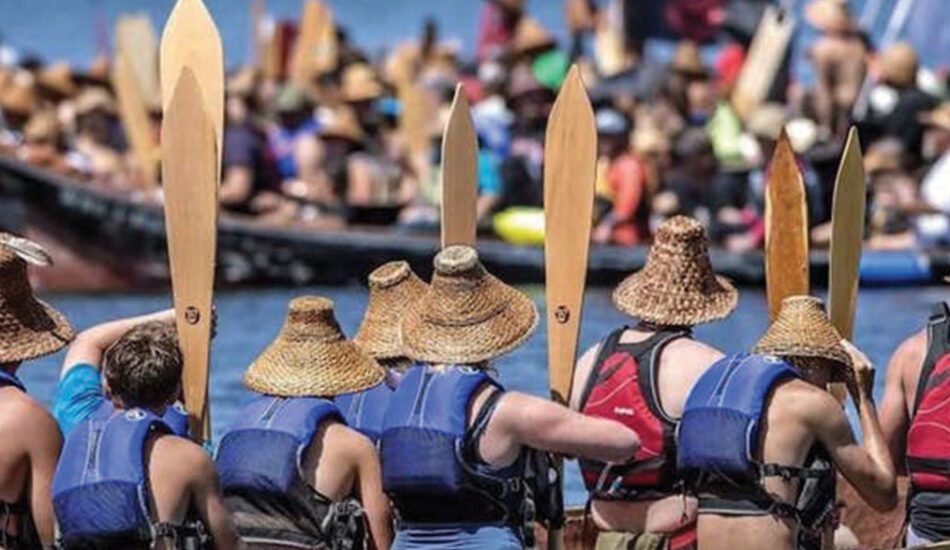By RICHARD WALKER
(Article courtesy of Indian Country Today and author Richard Walker.)
A Coast Salish sculpture that will be installed in 2020 at a historic Puyallup village site in the Tacoma, Washington, suburb of Gig Harbor, will be a tribute to the strength, resilience and enduring presence of the Puyallup people—as well as a symbol of healing between the Native and non-Native communities.
The project, called the Honoring Project, is funded by the City of Gig Harbor and the local Kiwanis Club, with matching funds from the Puyallup Tribe. The project was initiated in 2015 by Gary Williamson, a retired elementary school principal, as a way to “fill in a missing chapter in Gig Harbor’s history book.”
“Several years ago, I noticed that there are no street names, nor public art nor any formal acknowledgment of Gig Harbor’s Indigenous people,” he said. “It’s time that story was told. It’s long overdue.”
The 15- by 4-foot artwork will be installed at Austin Estuary Park, which at the time of the grandparents’ grandparents was tuwawəϯqəϯ (twah-well-kax), the main village of the sxwəbabš (sk-WHUHbabsh) band of Puyallups.
To educate, inspire and help understand
The finished work will have a massive world of cultural relevance and survival behind it.
This area was ground zero in the Fish Wars of the 1960s and 1970s. Here in south Puget Sound, Native Americans stood up for their right to harvest fish in accordance with treaties their leaders and United States representatives signed 100 years earlier.
State and local law enforcement officers brutalized and jailed Native fishermen and women to prevent them from fishing in their usual and accustomed areas as allowed by the treaty. Fisheries officials and non-Native fishermen blamed Indians, who comprised 1 percent of the state’s population, for declining salmon numbers caused by recreational and commercial fishing.
A 1974 federal court decision upheld treaty fishing rights—Indians 50 percent of the available harvest, non-Indians 50 percent of the available harvest—and established Treaty Tribes as co-managers of the state’s fisheries.
“The purpose of this project is to educate, inspire and help people understand the First People of this community,” Honoring Project committee member Mark Anderson, Cowlitz, said. “For many years, there was not a whole lot of love between the Native and non-Native communities. This will help the peace process. It’s time for understanding.”
Puyallup culture bearer Connie McCloud said this project can help build bridges of understanding between peoples. Some non-Native fishermen still have hard feelings toward Native fishermen, she said.
“But the community is making steps [toward healing]. I believe the community supports recognizing the history of those village sites and that these lands were originally Puyallup.”
An enduring presence
The Puyallup Tribe’s presence is not drowned out by the towering landscapes and political forces of the cities within its reservation. The Tribal Council issued a stop work order on the construction of a proposed liquified natural gas plant in Tacoma, citing risks to public safety and the environment; later, the Puget Sound Clean Air Agency ordered another environmental impact study, ruling that the first study touted liquified natural gas as a cleaner fuel source without evidence to prove that statement.
Nearby freeway signs noting exits into Tacoma are signs reminding motorists they are “Entering the Puyallup Indian Reservation.” The Puyallup Tribe’s Emerald Queen Casinos and hotel are visible from Interstate 5. The Cancer Treatment Center of America on Pacific Highway is now the Puyallup-owned Salish Cancer Center. A towering welcome figure carved by Puyallup artist Shaun Peterson stands in downtown Tacoma. About 750 students attend the Puyallup Tribe’s Chief Leschi School. Annually, 3.5 million salmon and steelhead begin their journey to Puget Sound and the open Pacific Ocean from the tribe’s hatchery on the Puyallup River.
To Puyallup Tribe Chairman Bill Sterud, his tribe’s presence and sovereignty are as enduring and unchanging as the namesake river that still flows from Mount Rainier—Tacobet (təqʷúʔbəʔ), “Mother of Waters”—through Puyallup lands to Puget Sound.
Sterud’s statement issued during the 2018 Canoe Journey/Paddle to Puyallup will undoubtedly be reflected in the art to be installed at tuwawəϯqəϯ: “We know intimately the effects of industry and development on our culture. We must balance city living with the need to protect the way of life our ancestors practiced before freeways and industry transform our land.





